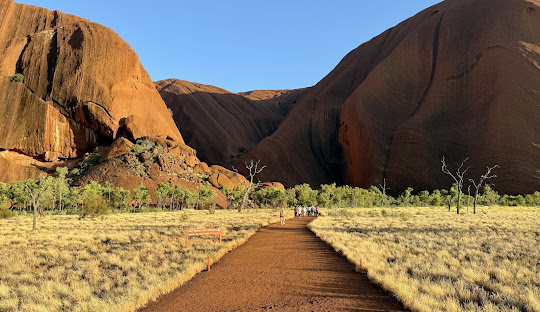Uluru, Australia
"Uluru: Australia's Majestic Monolith and Cultural Heartbeat"
Uluru, also known as Ayers Rock, is one of the most iconic natural landmarks in Australia and holds deep cultural significance for the Anangu people – the traditional owners of the land. Standing at 348 meters (1,142 feet) tall and with a circumference of 9.4 kilometers (5.8 miles), Uluru is a massive sandstone monolith located in the heart of the Northern Territory’s Red Centre. Its incredible size, striking color changes, and mystical presence make it one of the most visited natural attractions in Australia.
🌟 Why Visit Uluru?
🏜️ A Sacred Cultural Landmark
Uluru is not just a geological wonder; it is a deeply sacred site to the Anangu people, who have lived in the region for thousands of years. The rock formation and surrounding landscape are rich with dreamtime stories, cultural traditions, and ancestral connections. As a visitor, it’s important to understand the cultural significance of Uluru and respect its role in indigenous heritage. Visitors are encouraged to not climb Uluru, as it is sacred to the Anangu people. Instead, there are numerous walking trails that allow you to explore its beauty respectfully.
🌅 Breathtaking Sunrises and Sunsets
One of the most magical experiences at Uluru is witnessing the stunning sunrise and sunset. As the sun rises and sets over the desert landscape, the rock’s surface changes in color, shifting from a deep red to shades of purple and orange. The Field of Light, a stunning art installation by Bruce Munro, also adds to the mystical experience with thousands of solar-powered lights illuminating the landscape at dusk.
🥾 Hiking and Exploration
Uluru offers several walking trails for visitors to explore its base, learn about its cultural history, and take in the majestic views. Some popular walking tracks include:
-
Base Walk: This 10.6-kilometer walk takes you around the entire base of Uluru, allowing you to experience its changing textures, colors, and views. The track is easy and relatively flat, making it accessible for most visitors.
-
Mala Walk: A short, 1-kilometer walk that explores the rock’s history, flora, and fauna, this trail includes informative displays about the cultural and spiritual significance of Uluru.
-
Kata Tjuta (The Olgas): Located about 50 kilometers from Uluru, the Kata Tjuta rock formations are another must-see. The Valley of the Winds walk is a challenging hike that takes you through the domed rock formations, offering breathtaking panoramic views.
🌿 Flora and Fauna
Uluru is surrounded by a unique desert ecosystem that’s home to a variety of plants and animals. You may encounter kangaroos, dingoes, emus, and bats. Birdwatching is also popular, with over 170 species of birds spotted in the area, including the pink cockatoo and the peregrine falcon. The plant life is just as diverse, with many species adapting to the harsh desert environment, such as spinifex grasses and desert oaks.
🛍️ Cultural Experiences and Art
Uluru is not just about natural beauty – it’s also a place to immerse yourself in aboriginal culture. The Uluru-Kata Tjuta Cultural Centre offers insightful exhibits about the Anangu people, their connection to the land, and their traditional practices. There are also opportunities to purchase authentic Aboriginal art and handicrafts from local artists, which makes for a meaningful souvenir.
🌤️ Today's Weather at Uluru
Today, Uluru enjoys clear skies and warm temperatures around 30°C (86°F). The desert climate offers pleasant sunny conditions for exploring during the day, but be prepared for a sharp drop in temperature once the sun sets. By evening, temperatures will dip to 15°C (59°F), so it’s advisable to bring a light jacket or sweater if you're planning to stay for sunset. The dry air and clear skies also offer excellent visibility, perfect for stargazing after dark.
🚗 How to Get There
-
By Air: The closest airport to Uluru is Ayers Rock Airport (Connellan Airport), located just 20 kilometers from the rock. It is serviced by flights from Sydney, Melbourne, and Alice Springs. From the airport, a short transfer takes you to the Uluru-Kata Tjuta National Park.
-
By Road: If you prefer driving, Uluru is located about 450 kilometers from Alice Springs, which is about a 5-hour drive. The drive through the Outback offers stunning landscapes and is an experience in itself.
-
By Coach: There are several tour operators offering guided tours to Uluru from Alice Springs and other nearby towns.
🍴 Dining and Refreshments
-
Talinguru Nyakunytjaku: Located near the base of Uluru, this area has a café that serves snacks, coffee, and drinks with an incredible view of the rock.
-
Sounds of Silence Dinner: For a unique experience, enjoy a dinner under the stars at the Sounds of Silence Dinner, where you can savor local cuisine while taking in the beauty of Uluru at dusk.
-
Ayers Rock Resort: The resort near Uluru offers several dining options, including Australian BBQs, Indigenous-inspired dishes, and modern Australian cuisine.
🛌 Where to Stay
-
Ayers Rock Resort: The closest accommodation to Uluru, offering a range of options from luxury hotels to camping grounds. Popular choices include the Sails in the Desert Hotel, a 5-star resort with spa services, and the Outback Pioneer Hotel, which offers more budget-friendly options.
-
Campgrounds: For a more rustic experience, there are campgrounds near the resort that allow visitors to camp under the stars and enjoy the desert surroundings.
-
Luxury Lodges: For those seeking ultimate luxury, consider staying at Longitude 131°, an exclusive luxury lodge offering panoramic views of Uluru from your private tented suite.
💬 Final Thoughts
Uluru is a must-see destination for anyone visiting Australia. Its natural beauty, spiritual significance, and rich cultural history make it one of the most iconic and awe-inspiring places on Earth. Whether you’re hiking around the base, experiencing the colors of the sunrise, or simply enjoying the stillness of the desert, Uluru offers a transformative experience.


